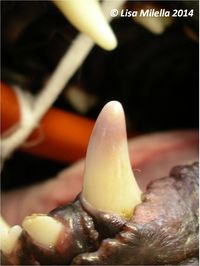Dental Discolouration
Introduction
The normal colour of teeth varies and depends on the shade, translucency and thickness of the enamel.
Teeth can discolour following trauma to the tooth. It can be any colour from pink to black, resulting from the haemoglobin breakdown products settling in the dentinal tubules. Studies show that 92% of discoloured teeth have irreversible pulpitis. The pulp may then get secondary infected by anachoresis.
There are two basic kinds of discolouration:
- Intrinsic staining: secondary to endogenous factors discolouring the underlying dentine
- Extrinsic staining: from surface accumulation of exogenous pigment
Discolourations can also be generalised or local, and pseudodiscolourations refer to extrinsic staining by dental plaque or agents in foods.
Discolouration of teeth is extremely common in all animals and affects all species and all breeds.
Aetiology
Extrinsic Staining
Bacterial stains: green to black-brown to orange colour, from chromogenic bacteria.
Plaque-related: black-brown stain, due to the formation of ferric-sulfide from interaction of bacterial ferric sulfide and iron in the saliva.
Foods: charcoal biscuits can penetrate pits and fissures in the enamel, green from foods containing abundant chlorophyll.
Dental restorative materials: black-grey from amalgam (rare in animals)
Medications: most commonly tetracyclines given prior to development of the permanent teeth.
Metal: wear from chewing on cages or from removed endodontic bands or wires
Discoloured restorations
Tooth wear and dentin exposure: secondary dentin, tertiary dentin, reparative dentin
Intrinsic Staining
Red blood cell destruction: following traumatic injury to the tooth. Haemoglobin breakdown in the pulp from a pulpitis, which progresses from pink to grey to black.
Amelogenesis imperfecta: developmental alteration in the structure of the enamel, giving a chalky appearance. The teeth may appear pinkish in colour due to the visible pulp through the poor quality enamel.
Internal Resorption
Pulpal injury causes vascular changes with increased oxygen tension and a decreased pH, resulting in destruction of the tooth from within the pulp from dentinoclasts.
The tooth has a pinkish hue.
External Resorption
This is caused by many conditions such as trauma, orthodontic treatment, periodontal disease, tumours and periapical inflammation. Osteoclasts resorb the tooth structure.
Medications
Tetracycline: binds to calcium and forms a calcium orthophosphate complex that is laid down into the collagen matrix of the enamel. It results in a yellow-brown discolouration. This can only occur when the enamel is being formed.
Amalgam
Iodine or essential oils
Macrolide antibiotics: hypocalcification leading to white lesions with horizontal stripes on the enamel
Clinical Signs
There will be abnormal colouration of a tooth or teeth.
There may only be rings or lines of discolouration.
Diagnosis
There may be a history of treatment with a particular drug or supplement, or a history of trauma.
If the animal is young this may indicate a developmental process.
Food or plaque-related discolourations should be obvious on close dental examination and probing.
Radiographs should be performed to assess the viability of the tooth.
Treatment
For extrinsic staining, internal or external bleaching can be performed, or veneers or crowns can be placed on the tooth.
For intrinsic staining, endodontic treatment is often the treatment of choice.
Restorative procedures such as crowns or veneers will protect both the tooth and the pulp.
Unfortunately, the discolouration often persists following treatment.
| Dental Discolouration Learning Resources | |
|---|---|
 Test your knowledge using flashcard type questions |
Veterinary Dentistry Q&A 04 |
References
Verstraete, F. (1999) Veterinary Dentistry Self-Assessment Colour Review Manson Publishing
Lobprise, H. (2007) Blackwell's Five Minute Consult Clinical Companion: Veterinary Dentistry Wiley-Blackwell
| This article has been peer reviewed but is awaiting expert review. If you would like to help with this, please see more information about expert reviewing. |
Error in widget FBRecommend: unable to write file /var/www/wikivet.net/extensions/Widgets/compiled_templates/wrt672938a3c56f21_37693856 Error in widget google+: unable to write file /var/www/wikivet.net/extensions/Widgets/compiled_templates/wrt672938a3cb9692_77551119 Error in widget TwitterTweet: unable to write file /var/www/wikivet.net/extensions/Widgets/compiled_templates/wrt672938a3d12416_01718420
|
| WikiVet® Introduction - Help WikiVet - Report a Problem |
